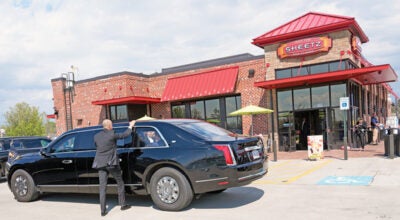PROFILE 2013: What would John think?
Published 6:16 pm Saturday, March 2, 2013
Much has changed since days of Ironton founder
The first thing Ironton founder and industrialist John Campbell would probably say if he came back to earth today is, “What did they do to my house?”
The three-story, early Victorian buff brick mansion was a labor of love for the poor farm boy from Georgetown who made good, taking close to a year to have it rise from the corner lot at Fifth and Lawrence streets.
One of the first mansions in Ironton, the house features rooms larger and more spacious than some of the other homes built by his equally affluent compatriots in the pig iron industry.
Campbell first came to what was then called the Hanging Rock area in the 1830s to meet and become friends and associates with men like Robert Hamilton and Andrew Ellison to partner and build the Lawrence Furnace, the Hanging Rock Iron Forge and the Mt. Vernon Furnace.
Over the next 40 years, Campbell built his fortune, which in 1872 was inventoried to be at $1 million in assets. Twenty years earlier he decided to celebrate some of his success with the construction of his dream home.
What that house didn’t have in Campbell’s day was a brick front porch, a coat of dusty yellow paint and that attachment in the back that would look to him like half stable-half outhouse.
If Campbell were making his journey back through the city he created with a 21st Century guide, he’d be told that curious addition to his house was once a garage used to house automobiles. No doubt he would be amazed and pleased at that ingenuity, the kind he always brought to his business dealings, like the time he pushed to make the Vesuvius Furnace the first hot blast erected in the United States.
After all, it was through industrialization that Campbell was able to become the powerful man that he was, even at the time of his death in Aug. 30, 1891. By that time his fortune was gone, but his influence remained strong and certain.
He might pause to tell his modern-day companion how crowds gathered in front of his house at the hour of his funeral to show their respect.
“For a square the people congregated in throngs, testifying to the universal respect in which Mr. Campbell was held,” The Ironton Register reported. “The attendance included everybody, of all beliefs, colors, conditions, the rich and poor, the old and young. Never was there such a throng at a funeral in this town.”
A cortege of 60 carriages followed the hearse bearing his body to Woodland Cemetery. It included city police and U.S. mail carriers.
He would certainly tell his new friend how his fortune started when he saved up $600 from his wages as a general clerk in a store in Ripley to buy part interest in the steamboat “Banner.”
From there he discovered the Hanging Rock furnace district and used his acumen to become the founder of Ironton.
As the two would enter the house, Campbell would feel again the gracious ambience where he and his wife, Elizabeth, brought up their seven children. He would surely be pleased so many of the house’s architectural features are still intact, like the black walnut cantilevered staircase. Or the hand-pegged parquet floor that he had installed in his study from an intricate design he saw while traveling in Europe with his daughter, Clara.
Looking out the second floor windows on the Lawrence Street side, much of what Campbell would see would look familiar as to the far left are still the towers of St. Lawrence O’Toole Roman Catholic Church and straight ahead the Presbyterian Church, built about 10 years before Campbell’s death.
He might tell his guide how that was once the spot where his barn stood and where many of the slaves he helped rescue would hide out before their journey to freedom in the north.
Over on the riverside of the house, looking out from the third floor windows of what was once the ballroom, Campbell would probably marvel at how fresh the sky looks. No longer are there dark clouds coming from the Belfont Furnace of his friend, Frederick Norton. Instead is the remnant of another industry, Meehan Steel, in the same spot where Norton’s works flourished.
Coming back down the staircase, but veering away from that dreaded porch, Campbell would be fascinated to discover the streets that he laid out and had recorded in 1849 are covered with a gray-black substance instead of the dirt he was used to. And no doubt he would be impressed that the hard white substance now used for sidewalks was introduced to Ironton by Norton’s son, Jessie Norton, in 1893, two years after Campbell’s death.
Then called artificial stone walk, Jessie Norton had it installed in front of Spencer’s Chapel, now First United Methodist Church, so his mother wouldn’t have to walk in the mud.
Walking down Railroad Street he would be surprised to see that Campbell knew as the main part of town — Front Street — is gone, replaced with high concrete walls and grassy levees as part of flood control not even considered in Campbell’s day.
At that time, Railroad Street boasted the Ironton House where Dr. R. J. Scott had his medical office; the Sheridan House, another hotel; Blake’s Building, home of A. Ford, Grocer; and S. Silverman and Brother, Gentleman’s Clothing in the Ward Building where Campbell probably got many of his satin vests and dress coats.
Before he started his jaunt to the river’s edge on Railroad, Campbell probably would look behind his house expecting to see the hops-fragrant steam pouring out of Leo Ebert’s Eagle Brewery, creators of fine lager beer, on the corner of Railroad and Seventh streets. Now there is only a vacant building and lot.
As he neared the river he would probably keep looking for the roundhouse for the Toledo, Delphos and Burlington Railroad on Front Street at the South corporation line, again obliterated by the 1937 flood control projects. That was a more than 100-mile rail line formed in 1879 that went from Dayton to Delphos. Three years later a branch line was constructed from Wellston to Ironton, the northern-most point of the Ironton and Huntington Railway.
Coming back from the river to the courthouse square, Campbell would look for Murdock and Co.’s wholesale grocers on the southwest corner of Second and Lawrence streets, and no doubt be amused that at close to that location is another grocery story.
And, as he started toward Fourth Street, he would surely stare at the massive courthouse with its majestic dome, a far cry from the long rectangular structure that served as the first courthouse built in Ironton, a year after Campbell’s house was erected.
Up on Fifth Street, Campbell would expect to see a church on the northeast corner of Center and Fifth streets, but not one so elaborate as the present-day turreted First Methodist Church. When Campbell was alive that corner was the site of Spencer’s Chapel, a two-story Federal style building. And across Center from the church was in Campbell’s day, the home of C. Ellison, president of Ironton Gas Co. and Lawrence Iron Works, not a limestone office building.
A walk down Fifth Street to the next block north would really confuse the industrialist. Where is Olive Street, he probably would ask. The first nine streets that he laid out, Campbell named after furnaces from Vesuvius to Vernon. Olive would be a particularly sentimental favorite for him since he started that furnace operation in 1847 with John Peters, the original owner of the Olive Foundry and Machine Shops. Sixteen tons came out of that blast furnace each day.
Standing there on the northeast corner, Campbell would probably stare in amazement at the brick structure his guide knows today as the Elks.
In Campbell’s day that land was originally owned by his company, The Ohio Iron and Coal Co. This is until he sold it to James Allen Richey in 1852 for $200. Then, in 1892, Richey sold it for $700 to James Nixon, who promptly conveyed it to a relative. There it stayed in the Nixon family until 1913, when it went into the Hart family for the next three years.
Then, in 1916, it was sold to the Ironton Lodge 177 of the Elks for $6,850. Two years later the lodge put up the structure that is there today.
On up to the south side of Vernon Street, between Seventh and Eighth streets, Campbell would be looking for the E.H. Jones Livery, coach and hack, but only see a residential area. A few years after Campbell’s death Jones moved his operation down to Third and Washington streets, where Yvonne DeKay dance studio is today.
Then as the 19th Century industrialist would come back to his beloved home, he might look up and see a tall man with a salt and pepper beard coming out of the side door of the house. He might stop and look at Campbell, partly because he would recognize him from the painting of the man in the foyer of the house. But also because he might think he’d seen the man before.
That’s because Ralph Kline, whose office is at the Ironton-Lawrence County Community Action Organization, isn’t sure if he hasn’t seen John Campbell before.
Like the time Kline and some of his colleagues were sitting around the conference table in a room on the third floor. The door onto the hallway was open and they saw a tall man walk past.
At that moment no one thought anything of it. Perhaps he was a messenger dropping a bill off or maybe a report. The group went back to talking until they all realized the stranger never walked back past their doorway.
Going out into the hall, they discovered no one was there. And there was no sign anyone had been there.
So maybe this fanciful tour of John Campbell through the streets of Ironton is simply whimsy, fun but unnecessary. Maybe Campbell already knows what changes have happened to the city he created and loved. Changes that would have confused and saddened him at times, but just as often thrilled him to see the spirit of progress that drove him is alive and well.
Maybe he has been here all along.




